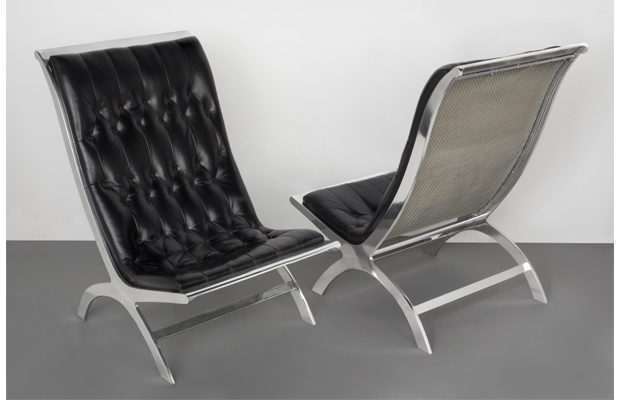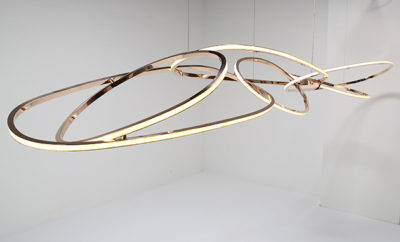
Design
John Vesey: Style and Scandal

Vesey’s “Maximilian” lounge chair, here a pair in polished aluminum and tanned calfskin upholstery, is derived from a Campeche chair.
John Vesey
Style and Scandal:
“A status item in many of the best dressed rooms these days is at least one piece of furniture by John Vesey” wrote the newspaper fashion columnist Eugenia Sheppard in May 1968. Owned by tastemakers ranging from Nelson Rockefeller to the Duchess of Windsor, Vesey’s chairs, sofas, tables, desks, and lamps, mostly crafted of metal, displayed clean lines and faultless proportions and were prominently featured in design publications and newspapers throughout the 1950s and ’60s. Today Vesey’s furniture is a cynosure among collectors of mid-twentieth-century design. As Gail Garlick of Good Design in Manhattan says, “Although Vesey designed his pieces to work well with antiques I think they are just as successful in contemporary interiors.” Garlick, who rediscovered Vesey’s furniture, has a selection of it ranging from aluminum and glass tables to aluminum benches and aluminum and leather chairs.
The designer was born John Vesey Colclough Jr. in Norfolk, Massachusetts, in 1924. Intending to become a museum curator, he attended Harvard University for a time but left to join the Merchant Marine. By 1948 he had dropped his last name and had become an antiques dealer specializing in eighteenth-century French furniture and fine art in New York. Seven years later he consigned the contents of his shop to Parke-Bernet Galleries for sale at auction. Vesey then began to design his own furniture. According to several newspaper articles he first sketched his designs, which were then produced to his exacting standards by Beacon Artisans, a custom manufacturer in the Bronx.
Rita Reif exclaimed in the New York Times in 1958 that “steel is putty in John Vesey’s hands.” His chairs are a case in point. Describing one that he based on the Campeche, or Cuban planter’s, chair, Reif reported that “Vesey translated the rosewood frame of the original into aluminum and the cane upholstery into aluminum fencing.” Called the “Maximilian” chair by the designer, a pair with leather upholstery is available at Good
Design. Reif added, “Mr. Vesey excels in adaptations of eighteenth- and nineteenth-century designs.” His other chairs based on historical designs included a reproduction of a Napoleonic campaign chair in steel and leather and an aluminum rocker inspired by a nineteenth-century bentwood Thonet piece.
Garlick points out that “with his Harvard education in curatorial studies, Vesey was a natural to become a great designer of American modern furniture.” He was able to draw on his knowledge of art history and select key styles from ancient Rome to the French monarchy to the Napoleonic Empire to imperial Austria to create his classical furniture.
In addition to chairs, Vesey’s catalogues presented a variety of coffee tables in plate glass with polished aluminum and brass trim or with just polished aluminum, a console table in plate glass with polished aluminum and brass trim, dining tables in plate glass or marble with polished chrome steel and brass, and occasional tables in polished steel with ornamental glass tops. Bases were available with several options to choose from, including saw horses or double t-bars. Besides the lounge chair in polished aluminum and leather or just aluminum, the “Maximilian” line also extended to a sofa or a bench in different lengths and widths as well as a table in polished aluminum and aluminum mesh with an inset top that could be ordered in glass, marble, or wood. Vesey also designed a hurricane lamp as a form of outdoor lighting. Another piece was a folding bench in aluminum based on the sella curulis, a Roman magistrate’s cross-legged stool.
In a 1969 article on horn furniture, Vesey stated, “I’ve always had a bee in my bonnet to make antler furniture in aluminum. I want to copy this 1800 antler chair in metal. It would be a real kooky chair for a far-out apartment.” Whether he actually ever produced horn furniture in metal is not known, however.
One of Vesey’s most coveted pieces during the late 1950s and ’60s was a desk made of steel with gilt-bronze trim and a leather top and fitted with three false drawers and three true drawers lined in suede. The left-hand drawer was fitted as a safe with a combination lock. Based on Gilles Joubert’s red lacquer bureau plat for Louis XV, now in the Wrightsman Galleries at the Metropolitan Museum of Art, Vesey reinterpreted Joubert’s rococo form in the bold, straight lines and geometrical form popular during the reign of Louis XVI. Sheppard wrote that the desk took six months to produce and that the reclusive billionaire Howard Hughes bought it on sight. Count Rodolfo Crespi, an international editor for Vogue, and the American socialite Countess Sunny von Bulow also each purchased one. Vesey featured the desk in “a coffee with a client” vignette when he was one of five men-about-town invited to design table settings at New York retailer B. Altman and Company. (The others were the theater critic Rex Reed, the jewelry designer Kenneth Jay Lane, the fashion designer Bill Blass, and John Nicholson, the owner of Café Nicholson.) Garlick is always on the hunt for one of these remarkably beautiful and versatile desks.
In 1965 Bill Cunningham, writing for the Chicago Tribune, described Vesey as “the leader in opulent modern glass, steel, and leather furniture of exceedingly fine taste.”
Newspaper articles consistently emphasized the popularity of Vesey’s furniture among the trendsetters of the period. Besides those already mentioned, his well-heeled clients also included the French fashion designer Hubert de Givenchy, Andy Warhol’s muse Jane Holzer, Hotel Carlyle owner Mrs. Peter Sharpe, Bobby Kennedy, and Anne McDonnell Ford.
In December 1971 John Vesey’s fame and fortune came to a lurid end when he was arrested, convicted, and then sentenced to five years in prison for sexually assaulting and seriously injuring a seventeen-year-old high school boy he had picked up at New York City’s Port Authority. After completing his sentence, Vesey moved to Rhinebeck, New York, where he reputedly bought and sold antiques privately, and where he died in 1992.
But infamy never dampened enthusiasm for Vesey’s work. In March, for instance, Wright in Chicago offered his nine-foot-long black leather and aluminum chesterfield sofa with a presale estimate of $7,000 to $9,000. It sold for $68,500.












